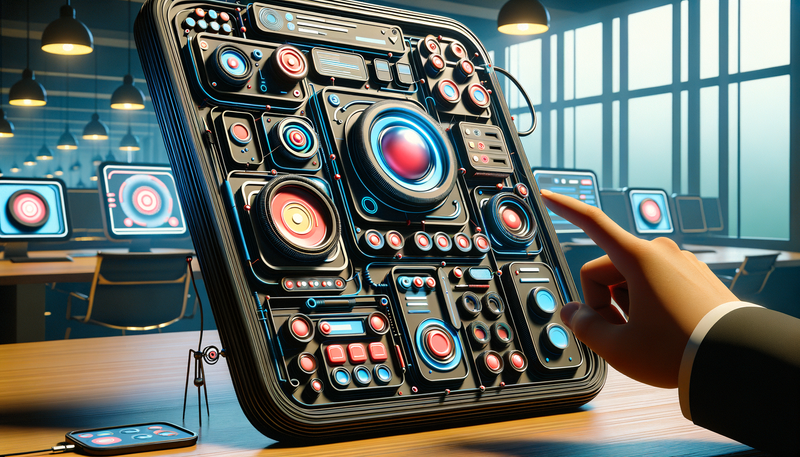The Impact of Neumorphism in UI Design
Neumorphism, a design trend that emerged in late 2019, has been making waves in the world of UI design. This style combines elements of skeuomorphism and flat design to create a soft, realistic look that mimics physical objects. Neumorphic interfaces feature subtle shadows and highlights, giving the impression of elements being pressed into or extruded from the background. This article explores the principles of neumorphic design, its impact on user interfaces, implementation techniques, and best practices for creating engaging and visually appealing UI elements. We'll delve into the advantages and challenges of this trend, as well as its potential future in the ever-evolving landscape of web design.Table of Contents:

Understanding Neumorphism
Neumorphism, a portmanteau of 'new' and 'skeuomorphism,' is a design approach that aims to create a soft, extruded plastic look in user interfaces. It combines the realism of skeuomorphism with the simplicity of flat design, resulting in a unique aesthetic that mimics physical objects.The key characteristics of neumorphic design include subtle shadow effects, soft color palettes, and the illusion of depth. UI elements appear to be pushed into or pulled out of the background, creating a tactile and visually appealing interface. This style often uses monochromatic color schemes with slight variations in hue and saturation to achieve its distinctive look.
Do you need a website? Want to build a website but don't know where to start? Our website builder is the perfect solution. Easy to use, and with the ability to customize to fit your business needs, you can have a professional website in no time.
Principles of Neumorphic Design
To create effective neumorphic designs, it's essential to understand and apply the following principles:1. Soft shadows: Use subtle, dual-toned shadows to create the illusion of depth.
2. Minimal color palette: Stick to a limited color scheme with slight variations in shades.
3. Contrast: Maintain sufficient contrast between elements and background for accessibility.
4. Consistency: Apply neumorphic effects consistently across the interface.
5. Simplicity: Keep designs clean and uncluttered to maintain the soft, minimal aesthetic.
By adhering to these principles, designers can create visually appealing and user-friendly neumorphic interfaces that stand out in the digital landscape.
Implementing Neumorphic UI Elements
Creating neumorphic UI elements requires careful attention to detail and a good understanding of CSS. Here are some key techniques for implementing neumorphic design:1. Box-shadow: Use multiple box-shadow properties to create the characteristic soft shadow effect.
2. Border-radius: Apply rounded corners to elements for a smoother appearance.
3. Background gradients: Utilize subtle gradients to enhance the 3D effect.
4. CSS filters: Employ blur effects to soften shadows and highlights.
5. SVG filters: For more complex shapes, SVG filters can be used to create advanced neumorphic effects.
It's important to note that while CSS can achieve most neumorphic effects, some designs may require the use of graphics software for more intricate elements.
Building a website with SITE123 is easy
Best Practices for Neumorphic Design
When incorporating neumorphism into your UI design, consider the following best practices:1. Maintain accessibility: Ensure sufficient contrast and legibility for all users.
2. Use sparingly: Apply neumorphic effects to key elements rather than the entire interface.
3. Consider user interactions: Design clear hover and active states for interactive elements.
4. Balance with other design styles: Combine neumorphism with flat or material design for visual variety.
5. Optimize performance: Be mindful of the impact on page load times, especially on mobile devices.
6. Test across devices: Ensure the design looks consistent and functions well on various screen sizes and resolutions.
By following these best practices, you can create visually appealing neumorphic interfaces that enhance user experience without sacrificing functionality or accessibility.
The Future of Neumorphism in UI Design
As with any design trend, the future of neumorphism is subject to evolving user preferences and technological advancements. While it has gained popularity in recent years, its long-term viability remains to be seen.Pros of neumorphism include its visually appealing aesthetic, potential for creating intuitive interfaces, and ability to stand out in a sea of flat designs. However, challenges such as accessibility concerns, potential overuse, and performance issues may limit its widespread adoption.
Moving forward, we may see a more balanced approach, where designers incorporate neumorphic elements selectively alongside other design styles. This hybrid approach could lead to innovative and engaging user interfaces that combine the best aspects of various design trends.





